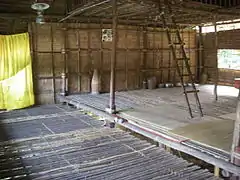Iranun people
The Iranun are a Moro ethnic group native to Mindanao, Philippines, and the west coast of Sabah (in which they are found in 25 villages around the Kota Belud and Lahad Datu districts; also in Kudat and Likas, Kota Kinabalu).
_Moro_'pirate'.jpg.webp) A 19th century illustration of an Iranun pirate. | |
| Regions with significant populations | |
|---|---|
(Bangsamoro, Soccsksargen, Northern Mindanao, Zamboanga Peninsula, Manila, Cebu) | |
| Languages | |
| Iranun, Maranao, Maguindanao, Sabah Malay, Chavacano, Cebuano, Filipino, English | |
| Religion | |
| Sunni Islam | |
| Related ethnic groups | |
| Maranao, Maguindanao, Lumad, Sama-Bajau, other Moro peoples, Visayans, other Filipinos, other Austronesian peoples |
Origins

The name "Iranun" has the same meaning as the name of the Maranao people, meaning "people of the lake", referring to Lake Lanao.[1] They are both closely related, along with the Maguindanao people (whose name can also be translated to mean "people of the lake"),[2][3] "Iranun" (archaic "Iranaoan") may have been the original endonym of the ancestral group which later split into the Iranun, Maranao, and Maguindanao people. The Iranun and Maranao still speak the language closest to the ancient Proto-Danaw among all of the Danao languages spoken by these groups.[4]
The modern Iranun are believed to be descendants of Maranao who left Lake Lanao and settled elsewhere. These migrations were usually of merchant clans of the Maranao which established trading routes near the coast. Some Iranun clans, however, are descendants of outcast clans that left Lake Lanao after one of their clan members committed a murder. This was to avoid the open retaliatory conflicts that usually result due to the tradition of rido. This has occurred multiple times in the history of the Maranao, with one recorded incident in 1966 when an entire kin group disappeared overnight after a murder. Most Iranun settled coastal areas of the Illana Bay and Maguindanao, but a few migrated to Sulu or further onward to Sabah. A clear evidence of this is recorded in the salsilas (genealogies) of the Iranun, which still mention grar (titles) with place-names that are clearly from Lanao, even though they do not inhabit those regions anymore.[3]
History
.jpg.webp)
For centuries, the Iranun were involved in pirate-related occupations in Southeast Asia. Lanun means pirate in Malay language. Originally from the Sultanate of Maguindanao, in southern Mindanao, Iranun colonies spread throughout Mindanao, the Sulu Archipelago and the north and east coast of Borneo. Most Iranuns are Muslim. Their language is part of the Austronesian family, and is most closely related to the Maranao people of Lanao. Historically, the Iranun were given the exonym Ilanun (also spelled variously as Illanun, Illanoan, Illanoon, Ilanoon, etc.) during the British colonial era. The Malay term Lanun or pirate originated from the exonym.
In the case of inter-marriages of an Iranun woman and an outsider man, the cultural influences of the woman's family will be more dominant that the outsider man would be considered as an Iranun man; although in a lot cases this does not happen.[5]
For several centuries, the Iranuns in the Philippines formed part of the Sultanate of Maguindanao. In the past, the seat of the Maguindanao Sultanate was situated at Lamitan and Malabang. Both of which were the strongholds of the Iranun society. Iranuns fought the Western invaders under the flag of the Maguindanao Sultanate. They formed part of the Moro resistance against the USA occupation of the Philippines from 1899 to 1913.[6] The Iranun were excellent in maritime activity as they are traditionally sailors and pirates.[6] They used to ply the route connecting the Sulu Sea, Moro Gulf to Celebes Sea, and raided the Spanish held territories along the way.
See also
References
- Hamilton, Roy W. (1998). From the rainbow's varied hue: textiles of the southern Philippines. UCLA Fowler Museum of Cultural History. p. 135. ISBN 9780930741648.
- Campbell, Gwyn (2018). Bondage and the Environment in the Indian Ocean World. Springer. p. 84. ISBN 9783319700281.
- Baradas, David B. (1968). "Some Implications of the Okir Motif in Lanao and Sulu Art" (PDF). Asian Studies. 6 (2): 129–168.
- Lobel, Jason William; Riwarung, Labi Hadji Sarip (2009). "Maranao Revisited: An Overlooked Consonant Contrast and its Implications for Lexicography and Grammar". Oceanic Linguistics. 48 (2): 403–438. doi:10.1353/ol.0.0040. JSTOR 40783537.
- Bandira Datu Alang (1992). Iranun: sejarah dan adat tradisi. Dewan Bahasa dan Pustaka, Kementerian Pendidikan Malaysia. p. 80. ISBN 98-362-2600-1.
- Kenneth Hite & Kennon Bauman (2016). The Cthulhu Wars: The United States' Battles Against the Mythos. Bloomsbury Publishing. ISBN 978-14-728-0789-2.
| Wikimedia Commons has media related to Iranun people. |